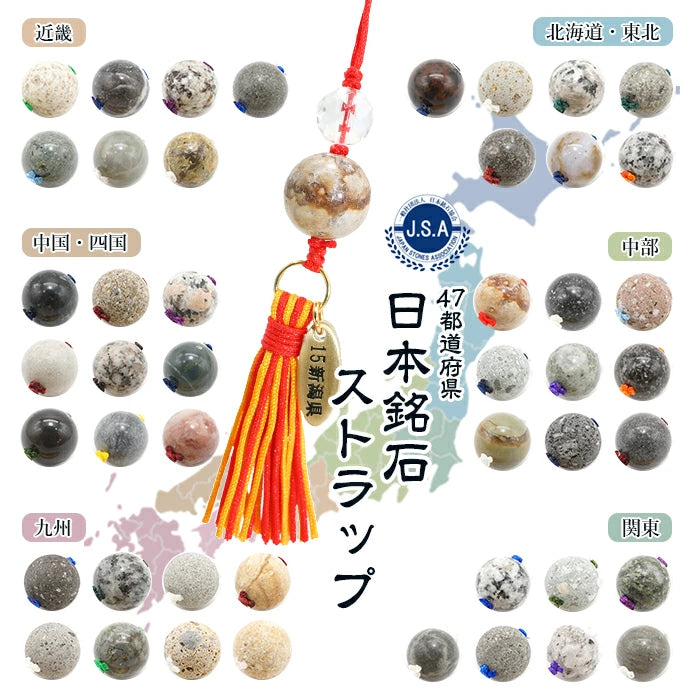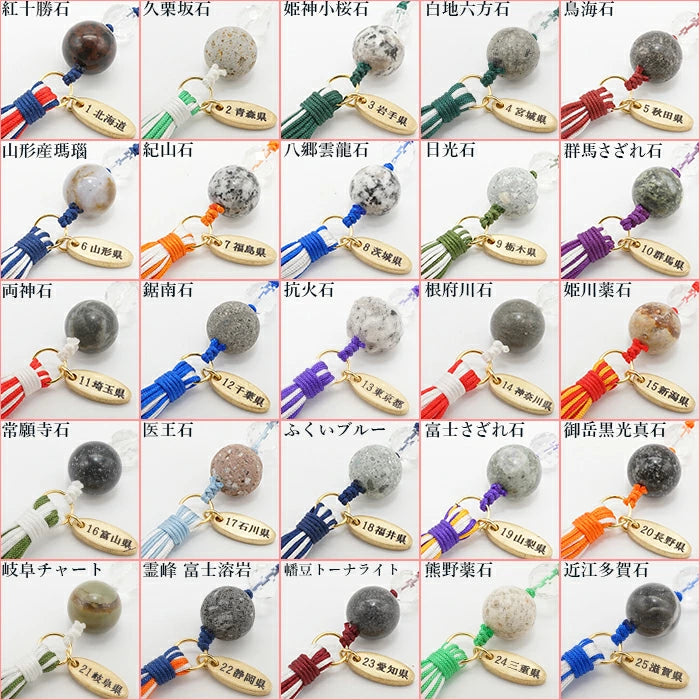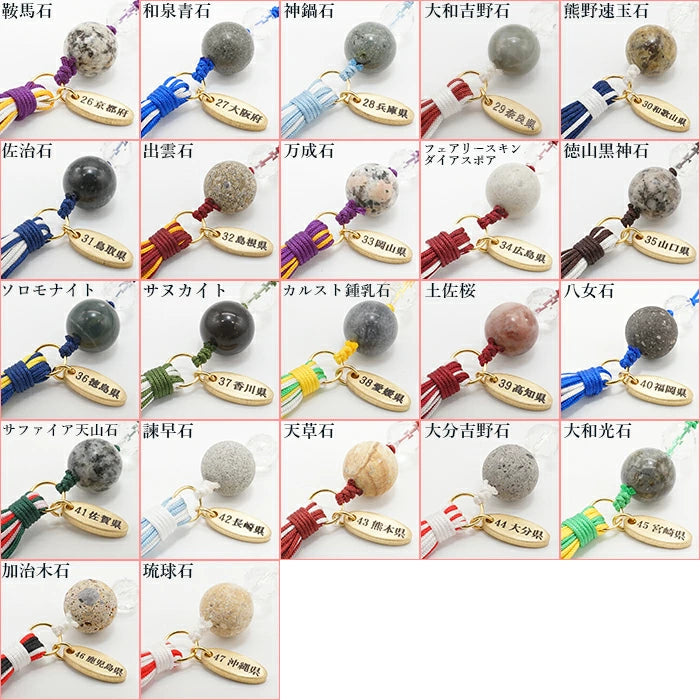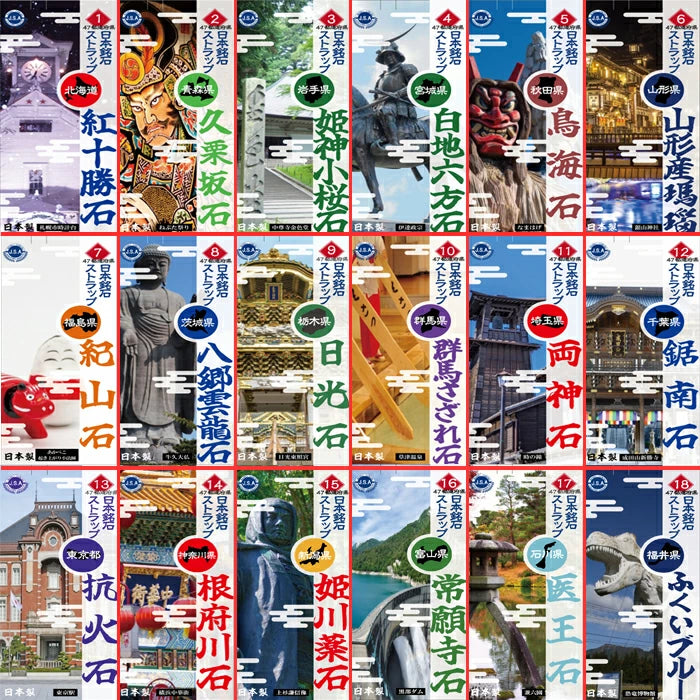Japan Stone phone charm
Japan Stone phone charm
Our very popular "Japanese Stone Strap" has conquered all types of stone in 47 prefectures and has been renewed!
A combination of Japanese stone beads (12mm) and colored tassels of each prefecture's flag.
Variations include Fuji lava, Fukui blue, and Himekawa medicinal stone, which are famous as Japanese stones, as well as a wide selection of colorful stones that have the unique power of the area where they are produced.
Japanese stones are full of charm and are impressive when all kinds are gathered together.
Enjoy your memory in Japan with the stones of the place you went or like.
Japanese famous stones are stones produced in various parts of Japan and registered on the famous stone list based on the regulations established by the Japan Stone Association.
At our company, buyers specializing in Japanese gemstones travel to mine sites all over Japan to gain the the rough stones that receive and process at our own factory.
As an official distributor of the Japan Famous Stone Association, we can introduce stones from all over Japan at affordable prices.
Variatios
Variatios
1. Hokkaido Red Tokachi Stone (Vermilion Obsidian)
Obsidian was born about 1.5 million years ago due to intense volcanic activity at Mt. Daisetsuzan.
Since ancient times, it has been processed into tools such as arrowheads and knives.
2. Aomori Prefecture Kugurizaka Stone
A stone produced near Kugurizaka in Aomori Prefecture.
Kugurizaka is the home of many deities related to water, such as Benten, who prays for maritime safety and good catches.
3.Iwate Prefecture Himegami Kosakuraishi
Himegami Kosakuraishi is a granite that makes up the entire Himegami Mountain.
The bronze statue of Nitobe Inazo in front of Morioka Station is also made of Himegami Kozakura stone. Inazo Nitobe is the author of "Bushido,'' which is widely read around the world.
4. Miyagi Prefecture Hexagonal stone
It is an intrusive rock of amphibole dacite, which is formed from lava that hardened underground and is jointed into pentagonal or hexagonal column shapes that grow from the ground.
Hexagonal stones are only available in a limited number of places in Japan, and most of them cannot be mined due to environmental protection.
5. Akita Prefecture Chokai Stone
The production area, Mt. Chokai, is located on the border between Yamagata and Akita prefectures, and is also called Dewa Fuji.
It contains quartz and feldspar, and is a very interesting stone when observed under a microscope.
6.Yamagata Prefecture Yamagata agate
In Yamagata, there has been the Dewa Sanzan mountain worship since ancient times, and Yamagata's chalcedony and agate are stones with a variety of shade are produced in a wide area of the Dewa Sanzan and Asahi Mountains.
7. Fukushima Prefecture Kiyama stone
A granite-type stone quarried in Shibayama, Kammisaka district, which straddles Iwaki City and Hirata Village, Fukushima Prefecture.
Kizan stone, with its beautiful silk-like skin, is a special stone because no other granite like this is produced in Hokuriku.
8. Ibaraki Prefecture Yusato Unryu stone
A type of granite produced from Mt. Kaba in Ishioka City (formerly Hachigo Town), Ibaraki Prefecture.
It was named Yusato Unryu stone because il loog like a dancing divine dragon fron a ink paiting (suibokuga).
9. Tochigi Prefecture Nikko stone
It is also called "Nikko Stone'' because of the stone on the Nikko Highway that leads to Nikko Toshogu Shrine, where Tokugawa Ieyasu is enshrined as Tosho Daigongen.
A member of the tuff family, it is soft and easy to work with, but it has many bubbles and a beautiful lava-like taste.
10.Gunma Prefecture Gunma Sazareishi
Ripple stones that appear in the Japanese national anthem "Kimigayo".
Limestone is made of limestone that has grown as its components have been washed away by rain and other factors, incorporating small grains of sand and stones.
11.Saitama Prefecture Ryokami stone
Ryogamiyama, one of Chichibu's three mountains, has been an object of worship since ancient times.
The stones of Mt. Ryokami are extremely hard, and it is known as a mountain mainly composed of chert.
12. Chiba Prefecture Kyonan tone
A precious stone collected from the strata of the Pliocene period of the Neogene period of the Cenozoic era, 2 million years ago.
13.Tokyo Prefecture Kouka stone
This stone is from Niijima, which belongs to the Izu Islands, and was created during an eruption 886 years ago.
When viewed under a microscope, the beautiful glassy fluid structure creates an attractive pattern that looks just like flowing water.
14. Kanagawa Prefecture Nefugawa stone
A stone associated with Tokugawa Ieyasu that was used in the construction of Edo Castle. Like Akabosa stone, it is produced in the surface layer of Komatsuite.
This stone is the result of the Hakone volcano erupting about 400,000 years ago, and the lava that flowed into the sea that rapidly cooled.
15. Niigata Prefecture Himekawa Yakuseki
A type of igneous rock quarried on the coast of Itoigawa City, Niigata Prefecture.
This stone has a long history of being called "tiger stone'' in Chinese medicine, and has been used for medical treatment since ancient times.
16.Toyama Prefecture Joganji Stone
A stone produced in the Joganji River in Toyama Prefecture. The Joganji River is a rapid stream that flows for a short distance of 56km from an altitude of 3000m.
The stones produced at Joganji Temple are called "Joganji Tamaishi'' because of the ball-like shape they get as they roll of from the mountain
17. Ishikawa Prefecture Ioh stone
This andesite is collected from Mt. Tomuro and Mt. Iou, and is said to have been created during an undersea volcanic eruption 15 million years ago during the Neogene Miocene.
18. Fukui Prefecture Fukui Blue
Echizen stone was discovered by Emperor Keitai. When wet with water, it turns deep blue.
It was also used for sarcophagi and stone pagodas during the Kofun period, about 1,500 years ago.
19. Yamanashi Prefecture Fuji Sazare Stone
The Fuji River, which flows along the sacred mountain Mt. Fuji, is a large river that flows from Nagano Prefecture to Yamanashi Prefecture and Shizuoka Prefecture.
Among the Fujikawa stones produced from the Fuji River, there are those that have a ripple-like appearance.
20. Nagano Prefecture Ontake Black stone
At 3,067m, Mt. Ontake is the second highest mountain after Mt. Fuji.
Ontake Black stone is an andesite stone that is mined in the form of cobblestones. It is black with a glassy luster, and if you look closely, you will notice that it has fine patterns, making no two pieces the same.
21.Gifu Prefecture Gifu Chart
It`s a fossils of radiolarians and sponges deposited on the ocean floor.
Gifu's chert is deposited from the Triassic period, and some of its production areas have been designated as natural monuments.
22. Shizuoka Prefecture Sacred Mountain Fuji Lava
This is lava from the eruption of Mt. Fuji in the 4th year of the Hoei era. It has a very high far-infrared radiation rate when applied to the skin, and is attracting attention as being effective in preventing sensitivity to cold and illness when applied to the skin.
23.Aichi Prefecture Hazu Tonalite
A stone used in the walls of Nagoya Castle.
Until recently, it was recognized as granite, but research has revealed that it is a different mineral called tonalite.
Important information please be sure to read
Important information please be sure to read
※ The photo is an image. The pattern, the color, and the way of lighting are slightly different one by one.
※ Due to the nature of the stone there can me some deformations, little differences on size, etc.
※We try to use photos close to the color of the actual product as much as possible. Depending on the PC and monitor, the color may be slightly different. Thank you for your understanding.
※Since we produce in series there is a possibility that the product that arrives will be slightly different from the photo.
Materials and care
Materials and care
Natural geomtone please handle with care
Couldn't load pickup availability
Share








